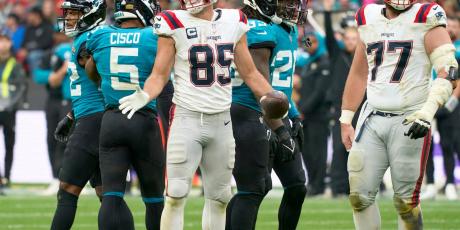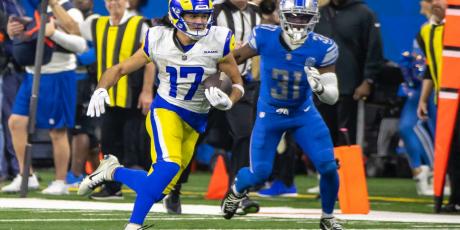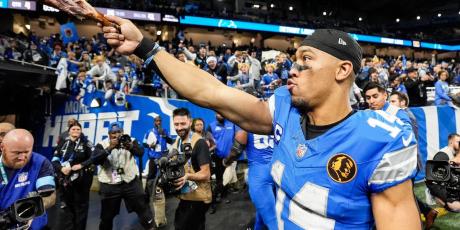Pinpointing Fantasy Football Sleepers (& Avoiding Traps)

Sleepers.
We all love them. But often, we drop them early in the season, before they've had a chance to establish their value. They end up being gobbled up from the waiver wire by someone else after a breakout game.
So how do we get ahead of the curve in fantasy drafts to find these forgotten talents?
It requires a disciplined approach, with an ability to use information and statistics -- rather than rhetoric -- to form opinions on players.
The hot takes from NFL television analysts do not help the cause in a game where week-to-week consistency is crucial. Our goal is to find players our league mates are passing over because they have ignored critical information that illustrates an opportunity to produce.
More than anything else, though, finding sleepers is about evaluating risk.
How much risk you can stomach should be a direct correlation to draft round. The deeper you go into a fantasy draft, the more tolerance you should have for a player with a low floor. The inverse is just as true -- and arguably more critical: The earlier you are in a fantasy draft, the less tolerance you should have for a player having a low floor (ask anyone who drafted some of those first-round running backs over the past few years).
Let’s look at some of the best practices for pinpointing sleepers:
Sleeper Drafting Guidelines
Compare Ranking to ADP
You simply cannot find sleepers without studying the nexus of trusted rankings and average draft position (ADP). Without a cross-comparison of the two, you are exercising the fantasy football equivalent of throwing darts at a dart board.
4for4’s rankings are a great place to start. Overall, they have been with most accurate rankings in the industry over the past six years, with 4for4 Senior Editor John Paulsen twice earning top honors for most accurate rankings along with a handful of top-5 accuracy awards as well.
Take your rankings and make sure you also include the latest ADP on each player in those rankings. 4for4’s rankings already do this for you with a column on the far right side of each rankings page indicating their ADP in both 10 and 12-team leagues.
Often you’ll find the highest ranked players at each position fall pretty close to in line with their ADP, but the deeper you get into drafts, a handful of names will start creeping up your rankings ahead of their ADP.
For example, in PPR leagues, Chargers running back Danny Woodhead has an ADP in the 7th round; however, he is the 16th-ranked running back in 4for4’s PPR rankings, ahead of a handful of backs with 3rd-6th round ADPs. This could allow you to reach on Woodhead a round early to ensure you get him but also pass on similarly ranked running backs in earlier rounds to take another position instead, thereby making your overall roster stronger.
Bounceback Candidates: Why Did They Have a Poor Season?
Often, sleepers are players who had poor seasons the year before, which results in other teams in your league passing on them because they no longer trust them. However, it’s important to makes sense of exactly why a player had a poor season; looking at their stat line isn’t enough.
For example, in 2014, Cardinals wide receiver Larry Fitzgerald had the worst fantasy season of his career (63-784-2). It wasn’t entirely his fault, as Carson Palmer missed over half the season and his backups were substandard. Regardless, Fitzgerald slipped to being the 29th receiver, on average, selected in 2015 drafts as a result. In a lot of 12-team leagues, he was still on the board in the 8th round. Entering his age-32 season, most thought he was washed up. They completely ignored the fact that the he had 82 receptions and 10 touchdowns the year before to go along with a stellar career resume. They also completely ignored that Fitzgerald’s quarterbacks for 10 games of 2014 were Drew Stanton, Ryan Lindley, and Logan Thomas. Those who looked beyond the box score and were bullish on Fitzgerald's chances at a bounceback in 2015 (4for4 and John Paulsen among them) were richly rewarded by Fitzgerald’s 2015 season, where he finished as WR7 in PPR leagues.
Another pitfall in pinpointing sleepers is ignoring talent and opportunity, instead emphasizing a season cut short by injury. Admittedly, it is harder to ignore the injury history of a running back over other positions because they take the biggest beatings, but at other positions, the red flags on injuries go too far. For example, Jeremy Maclin tore his right ACL in the summer before the 2013 season. He tore the same one in college but had more than a year to get ready for 2014, entering a Chip Kelly offense that produced a season of 82-1332-9 for DeSean Jackson (with Nick Foles at quarterback). Jackson was gone, leaving Maclin the opportunity. Maclin followed with 85-1318-10 season as the 25th receiver taken in 2014 fantasy drafts and an ADP in the 6th round of 12-team leagues.
When to Pass on an Overhyped Sleeper
It is okay to pass on players labeled as sleepers around fantasy football when they are coming off multiple healthy seasons that didn’t meet expectations. In those cases, those touting the sleepers are blindly lobbying a return to glory days while ignoring real data.
Two words: Trent. Richardson. Some were touting him as a sleeper in 2014, with a 6th-7th round ADP. The reasoning by many was that it would be his first full season with the Colts, after getting traded midseason from the Browns in 2013. He supposedly had a full grasp of the offense by then. Maybe that was true, but that’s not real data, is it?
Real data was Richardson averaging only 3.9 yards per carry as a rookie, regressing to 3.4 yards per carry in Cleveland in year two, and then dropping all the way down to 2.9 yards per carry after the trade in Indianapolis. The results? 3.3 yards per carry in his first (and final) full season with the Colts.
If the argument for a sleeper is more subjective than objective, it’s probably best to pass.
Who is the Offensive Coordinator?
Sometimes with sleepers, we have less objective data to go by with the player himself but more objective data to go by with the past results of his offensive coordinator.
Ahead of the 2015 season, TJ Hernandez studied what new Jets offensive coordinator Chan Gailey would mean to his weapons. What he found for running backs was interesting: even in Gailey’s last three years as a play-caller, when his top running back only received 56.3% of backfield touches, Gailey’s main back still averaged 14.9 PPR FP/G over his last four seasons, with two of those seasons resulting in RB1 finishes in terms of FP/G.
Savvy drafters knew this meant a great opportunity for Chris Ivory, with an ADP in the 8th round of 12-team leagues in 2015 drafts. Ivory finished as RB9 in standard leagues and RB12 in PPR leagues, averaging 13.5 PPR FP/G.
Drafters would have never considered Ivory based on his own objective data, which showed a failure to reach 900 rushing yards in five previous NFL seasons, but based on the objective data of his new offensive coordinator? Sleeper.
Have Patience; Don't Drop a Potential Sleeper too Early
Pinpointing sleepers is also about being patient. If you trusted a player enough to draft him, why would you drop him before the start of the season or a couple weeks into it, especially if it is before most of your starters even have a bye?
How many people drafted Odell Beckham Jr. as a rookie, only to drop him before he played a down in the NFL after he missed the first four games of 2014 due to injury? How many of those people went on to watch another team win a fantasy championship with Beckham?
How many people dropped Doug Baldwin on or before his Week 9 bye in 2015, after three straight single-digit PPR performances, despite the fact that still meant he posted 10 or more PPR FP/G in half his games to that point in the season, on a team that couldn’t find a way to incorporate Jimmy Graham into the offense and couldn’t get Marshawn Lynch healthy? Baldwin wasn’t even drafted among the first 30 receivers. What was the rush to drop him? Those that were patient were rewarded with a 23.9 PPR FP/G explosion over the final eight games of the season.
Is some of this hindsight? Yes. But those that don’t learn from history are doomed to repeat it.
Pinpointing Sleeper Quarterbacks
Past Success in the System
One poor season does not make a career. Ask those that passed on Cam Newton in the 7th-8th round of 2015 drafts, when he was the 10th quarterback off the board, and before he became the top fantasy quarterback of 2015.
Newton missed two games in 2014 and posted career lows in passing yards, yards per attempt, passing touchdowns, rushing attempts, rushing yards, and rushing touchdowns. However, his turnover rate was not any higher than it had been in previous years when he posted three consecutive top-5 fantasy quarterback seasons. Did I mention he was also in a car accident in 2014?
Newton had the same offensive coordinator (Mike Shula) going into 2015 that he had in 2013 when he finished third among fantasy quarterbacks. When a quarterback has posted many more seasons of fantasy production than disappointment, the drop in ADP is probably not warranted, especially if he has the same system and coordinator he’s thrived with in the past.
Pinpointing Sleeper Running Backs
Opportunity Cost: No Established Incumbent Starter
In the middle-to-late rounds of drafts, people too often draft a bigger name running back in a committee over a less sexy name that has actually won a larger role in his offense.
The 2010 Houston Texas were a perfect example. Arian Foster’s ADP finished in the 6th round of 12-team leagues, but I promise you that was skewed by late drafters. It was even lower for weeks, despite reports that he won the starting job in training camp and the preseason over Steve Slaton and Derrick Ward. Foster went on to rush for more than 1,600 yards. Could we have predicted that many yards? Of course not, but we do know you don’t even have a chance if you aren’t the starter.
You’ll find some of the other names drafted ahead of Foster in 2010 interesting. C.J. Spiller - a rookie who wasn’t the starter and rushed for 283 yards and 0 touchdowns. Ronnie Brown - who was splitting touches with Ricky Williams. Jonathan Stewart - who was in a three-person committee at the time with Mike Goodson and DeAngelo Williams. Beanie Wells was drafted almost two round earlier than Foster that season; he was on the wrong side of a timeshare with Tim Hightower.
There are more examples, but you get the point. In the middle to late rounds, pinpoint running back sleepers based on how much of the backfield pie they should get in the upcoming season.
Can He Catch?
In PPR leagues, an obvious but sometimes overlooked way to pinpoint running back sleepers is simply asking yourself if that back is utilized in the passing attack.
4for4’s 2016 PPR draft rankings illustrate this perfectly for running backs. 49ers running back Carlos Hyde caught 12 passes in 14 games his rookie season, followed by 11 receptions in seven games last year. Reports out of San Francisco are Shaun Draughn will continue to be utilized under Chip Kelly, similar to Darren Sproles’ pass-catching role in Philadelphia.
Yet Hyde is still being drafted in the 3rd round of PPR leagues, behind more proven dual-threat backs like Matt Forte, Dion Lewis, and Danny Woodhead. Even Giovani Bernard in a timeshare could post similar results to Hyde in PPR leagues, at a draft cost of four rounds later. That’s solid sleeper material. Amatuer fantasy players underestimate how much receptions affect running back scoring leaders in PPR leagues
Even deeper into 2016 drafts, a player like Theo Riddick is currently available in the 8th-11th round. He was second in the NFL in receptions among running backs in 2015 and finds himself in a backfield with no established starter. Duke Johnson is now coached by Hue Jackson, the man that made Giovani Bernard fantasy-viable in PPR leagues. Meanwhile, teammate Isaiah Crowell doesn't exactly inspire much confidence that he has a Jeremy Hill-like season in him.
Let us not forget the lessons of Alfred Morris from yesteryear, the blueprint for fading running backs with hands like a frying pan in PPR drafts.
Pinpointing Sleeper Wide Receivers
Fantasy Points Per Touch
John Paulsen annually pinpoints breakout receivers using advanced statistics. He is fond of fantasy points per target and with good reason. If a receiver is productive in limited snaps, it’s logical to assume he’ll be productive with more snaps.
That has been backed up by results in previous years. Paulsen wrote:
I featured Alshon Jeffery in the 2013 edition of this article. He posted a solid 1.14 FP/T (#37 in the league) on 48 targets during his injury-plagued rookie season. In his sophomore campaign he posted 1.24 FP/T on 149 targets, resulting in a #9 finish at his position.
In 2014, Golden Tate was the best example of a productive receiver who turned an increase in targets into a stellar fantasy season. As he joined the Lions, his targets jumped from 99 to 143, while his FP/T stayed relatively steady (1.21 in 2013, 1.10 in 2014). The result was a #13 finish at his position in standard formats.
This is another way to pinpoint sleepers, even as deep as the last few rounds of your draft.
Beware of Rookie Receivers
The amazing receiver class of 2014 (Sammy Watkins, Mike Evans, Odell Beckham Jr., Kelvin Benjamin, etc.) had many scrambling to find the next big thing in 2015 drafts, only to fail to keep the proper context around a strong historical trend. Rarely do rookie receivers produce consistently enough for fantasy purposes.
Amari Cooper’s 4th-round price tag wasn’t worth it in 2015, as has been the case with most highly touted receivers outside the 2014 class:
| Year | Position Rank (Standard) | FP/G (Standard) |
|---|---|---|
| 2015 | WR26 | 8.8 |
| 2014 | WR5 | 16.8 |
| 2013 | WR17 | 9.9 |
| 2012 | WR24 | 8.7 |
| 2011 | WR14 | 10.2 |
In 2015, Amari Cooper was the only rookie receiver close to reliable fantasy production. Seahawks wideout Tyler Lockett was the next closest rookie, finishing at WR43 in standard leagues.
In 2013, Chargers receiver Keenan Allen, a 3rd-round pick, finished at WR17 as a rookie in standard leagues. None of his fellow rookie wideouts finished inside the top 45 in standard leagues among receivers.
In 2012, Colts wide receiver T.Y. Hilton, another 3rd-round pick (not exactly on many fantasy draft radars), was the top scoring fantasy rookie receiver, with Justin Blackmon, a first-round pick, not too far behind at WR28 in standard leagues. The next closest rookie receiver that year finished at WR38.
Even the 2011 rookie receiver class didn’t come close to the success of the 2014 class. A.J. Green and Julio Jones finished at WR14 and WR17 in 2011, but that still wasn’t close to the five rookie receivers that finished among the top-25 scoring receivers in 2014 standard leagues. That doesn’t even include Brandin Cooks, who scored 8.6 FP/G in standard leagues as a rookie, right up there with the top rookie wideouts from years outside 2014.
2014’s rookie class of receivers was a huge outlier. Many chased those same results in 2015, resulting in fantasy doom. In future years, it’s important to know the history of rookie receivers when searching for sleepers. History shows us second-year receivers are more likely to breakout than rookies, and make better sleepers.
A Recap of Pinpointing Sleepers
There is a laundry list of ways to pinpoint sleepers in fantasy football drafts. To sum it all up, here are the best practices:
-
Use objective information/data, not subjective.
-
If a player is coming off a bad season, evaluate if it was actually the player’s fault or the result of an injury
-
Don't underestimate recent failure if it wasn't due to injury.
-
Target running backs that see significant usage, especially in the passing game.
-
Target wide receivers with high marks in fantasy points per target, and beware of rookies being overvalued.
Editor's Note: Early bird rates end June 30th for 4for4's Premium and DFS Subscriptions.
For more on Hue Jackson and advanced quarterback stats, check out last week's episode of The Most Accurate Podcast:
Related Articles
- The Raiders Have One of the Most Valuable Backfield Situations in Fantasy
- T.Y. Hilton Will Bounce Back with WR1 Numbers
- Using Advanced Stats to Identify 7 Breakout Running Backs
- Danny Woodhead Has RB1 Upside Again in 2016
- Yes, You Should be Using Zero RB in 2016
- Using Advanced Stats to Identify 7 Breakout Quarterbacks (and Busts)
- Sleeper Alert: Giants QB Eli Manning
- Using Advanced Stats to Identify 14 Breakout Receivers






















